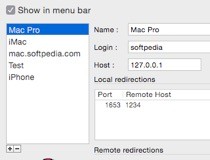

- #Setup ssh tunnel with cyberduck how to#
- #Setup ssh tunnel with cyberduck install#
- #Setup ssh tunnel with cyberduck password#
etc/pam.d/sshd auth required pam_securetty.so #disable remote rootĪuth required pam_google_authenticator.soīrute forcing is a simple concept: one continuously tries to log in to a webpage or server log-in prompt like SSH with a high number of random username and password combinations. With required pubkey and pam authentication, you may wish to disable the password requirement: If, on the other hand, you want to authenticate the user on both a publickey and the user authentication as required by your PAM setup, use a comma instead of a space to separate the AuthenticationMethods:ĪuthenticationMethods publickey ,keyboard-interactive:pam Then you can log in with either a publickey or the user authentication as required by your PAM setup. etc/ssh/sshd_config.d/nf KbdInteractiveAuthentication yesĪuthenticationMethods publickey keyboard-interactive:pam To use PAM with OpenSSH, edit the following files:
#Setup ssh tunnel with cyberduck how to#
Read the Duo Unix documentation for instructions on how to setup the necessary Duo credentials (Integration Key, Secret Key, API Hostname).
#Setup ssh tunnel with cyberduck install#
See Google Authenticator to set up Google Authenticator.įor Duo, install duo_unix AUR which will supply the pam_duo.so module.

This enables you to use public keys as well as a two-factor authorization.

SSH can be set up to require multiple ways of authentication you can tell which authentication methods are required using the AuthenticationMethods option. Two-factor authentication and public keys See SSH keys#Copying the public key to the remote server for more information. Warning: Before adding this to your configuration, make sure that all accounts which require SSH access have public-key authentication set up in the corresponding authorized_keys files. etc/ssh/sshd_config.d/20-force_publickey_nf PasswordAuthentication no This can be accomplished by setting the following options in the daemon configuration file: One of the most effective ways to protect against this attack is to disable password logins entirely, and force the use of SSH keys. If a client cannot authenticate through a public key, by default, the SSH server falls back to password authentication, thus allowing a malicious user to attempt to gain access by brute-forcing the password. Several other good guides and tools are available on the topic, for example: Ssh-audit offers an automated analysis of server and client configuration. Often the target of brute force attacks, SSH access needs to be limited properly to prevent third parties gaining access to your server. ProtectionĪllowing remote log-on through SSH is good for administrative purposes, but can pose a threat to your server's security. The logs of socket-activated instances of SSH can be seen by running journalctl -u as root or by running journalctl /usr/bin/sshd as root. Therefore, neither sshd.socket nor the daemon's regular rvice allow to monitor connection attempts in the log. Tip: When using socket activation, a transient instance of will be started for each connection (with different instance names). If the server is to be exposed to the WAN, it is recommended to change the default port from 22 to a random higher one like this: To have sshd use a particular key, specify the following option: Three key pairs are provided based on the algorithms rsa, ecdsa and ed25519. Public and private host keys are automatically generated in /etc/ssh by the sshdgenkeys service and regenerated if missing even if HostKeyAlgorithms option in sshd_config allows only some. from the /etc/issue file), configure the Banner option: To allow access only for some users, add this line: Whenever changing the configuration, use sshd in test mode before restarting the service to ensure it will be able to start cleanly.

Sshd is the OpenSSH server daemon, configured with /etc/ssh/sshd_config and managed by rvice. The instructions can now be made to use drop-in files. Reason: openssh 9.4p1-2 added Include /etc/ssh/sshd_config.d/*.conf to /etc/ssh/sshd_config.


 0 kommentar(er)
0 kommentar(er)
